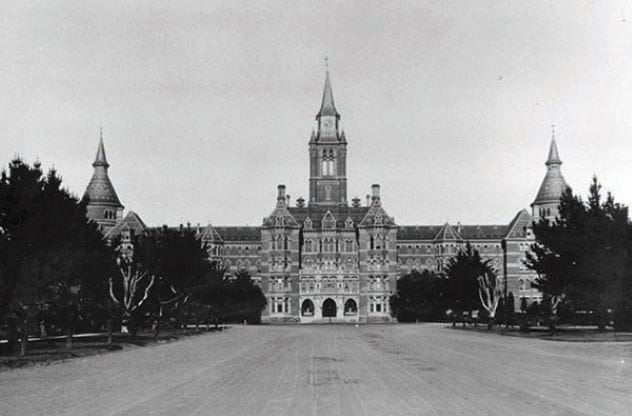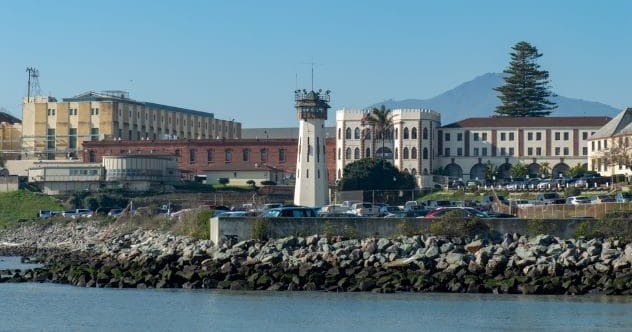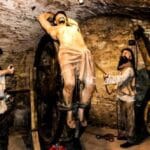San Quentin State Prison. The name alone sends shivers down the spine, doesn’t it? For centuries, it’s been California’s most infamous death row, a place synonymous with some of America’s most hardened criminals and unsettling events. Its walls have witnessed history, from the first execution in 1893 to Johnny Cash’s legendary performance in 1969 that cemented its outlaw image.
While California is now moving away from housing death row inmates at San Quentin, its reputation as one of the nation’s toughest, most violent, and restrictive jails endures. The stories that have seeped out from behind its formidable gates are often stranger and more terrifying than fiction. Join us as we delve into ten true, bone-chilling tales from the heart of America’s most notorious prison.
10. The Unreliable Gas Chamber
San Quentin has seen three methods of execution: hanging, gas, and lethal injection. Around 1938, the prison’s gas chamber became its primary method. However, its introduction was far from smooth. Before using it on a human, officials decided to test it with a pig. Shockingly, the animal took over 35 agonizing minutes to die. This was a major concern, especially since the manufacturer had claimed it would take a mere 15 seconds.
Warden Court Smith was deeply troubled, remarking, “Hanging is bad enough, but this—it’s terrible.” Despite these initial horrors, officials pressed on. Soon after, a riot at Folsom Prison resulted in four deaths, including the warden. The guilty parties were sent to San Quentin for execution by gas. Witnesses were traumatized by the spectacle. Albert Kessell, the first man to face San Quentin’s gas chamber, uttered his last words from within its confines: “it’s bad.”
9. Switching from Gas to Lethal Injection
For nearly six decades, the gas chamber remained the chosen method of execution. But in 1996, San Quentin shifted to lethal injection. The first inmate to be executed this way was William Bonin, infamously known as the Freeway Killer. Bonin confessed to torturing and murdering nearly two dozen young men and boys he picked up along California highways during the 1970s and 1980s. For over a decade, he terrorized hitchhikers, killing them in remote locations before his eventual capture.
Bonin seemed to almost enjoy the attention he received on death row. For his last meal, he had pizza and ice cream, and even watched Jeopardy the night before his execution. As protestors and supporters gathered outside the prison, Bonin was led to the chamber. His final words were chilling: “They feel that my death will bring closure. But that’s not the case. They’re going to find out.” Moments later, he became the first prisoner in California to die by lethal injection, after 13 years on death row.
8. The Builder Who Returned to His Creation
By 1990, San Quentin had executed 501 individuals. Each story is undoubtedly shocking, but Alfred Wells’s tale is uniquely ironic. In the 1930s, Wells was serving time for burglary and was assigned to help construct the prison’s gas chamber. The task unnerved him deeply. A fellow inmate recalled Wells saying, “that’s the closest I ever want to come to the gas chamber.” Little did he know what fate had in store.
After his release on parole, Wells began a relationship with his half-sister, which his family strongly disapproved of. Angered by their criticism, his temper flared, leading him to murder his half-brother and two other women. He went on the run but was eventually caught, convicted, and sent back to San Quentin – this time as a condemned man. In a cruel twist of fate, Alfred Wells was executed in 1942 in the very gas chamber he had helped build less than a decade earlier.
7. Egan’s Eagerness for the Gallows

During the Great Depression, Dallas Egan lived by whatever means necessary, primarily through burglary. As times grew tougher, Egan’s crimes escalated. In 1932, he and his gang robbed a jewelry store, stealing what would be around $100,000 today. During the heist, a 76-year-old man innocently entered the store to look at a watch. Seeing him as a potential witness, Egan shot him dead.
When Egan was arrested, he confessed. At his trial, the judge considered sparing his life with a long prison sentence. However, Egan seemed to have no desire to remain in society. “I can think of nothing better than the drop through the gallows,” he told the judge. “I’m a criminal at heart, and I want to be hanged.” The judge obliged. On his execution day, Egan enjoyed a hearty breakfast, a cigar, and whiskey for courage. He reportedly danced with glee on his way to the gallows and was hanged without offering any final statement. He was clearly ready to meet his end.
6. Decades Spent on Death Row

In 1978, 21-year-old Theresa Graybeal was carjacked by four men while buying dog food. They drove her to Fresno, pulled over on the outskirts of the city, and shot her at point-blank range, leaving her for dead. The justice that followed was inconsistent: one assailant received five years, a minor involved was granted immunity for testifying, another got 12 years, and Douglas Stankewitz was convicted of the murder and sentenced to death.
Stankewitz has always maintained his innocence, admitting he was in the car but denying he committed the carjacking or murder. By 2012, new information led an appeals court to reduce his sentence to life without parole. However, he continued to live on San Quentin’s death row, becoming its longest-ever resident. By 2022, he had spent an incredible 44 years on death row. He once mentioned in an interview that in all that time, he had only felt grass under his feet on five occasions. He still hopes for parole, but his life has been an extraordinarily long wait in the shadow of execution.
5. When Death Row Met Hollywood
Theodore Durrant was a medical student and assistant Sunday school director in late 19th-century San Francisco. His access to the Emmanuel Baptist Church and his medical knowledge culminated in a horrifying crime. Just before the turn of the century, Durrant brutally murdered two women, Blanche Lamont and Minnie Williams, by stabbing. Investigators likened him to Jack the Ripper. The bodies were found in the church belfry, placed on elevated boxes, presumably to slow decomposition. He was caught and sentenced to hang at San Quentin.
Durrant’s alarmed father, hoping to garner public sympathy, hired a camera crew to film inside the prison, intending to showcase his son’s supposed sensitive side. However, the plan backfired. The unedited film accidentally showed the prison warden’s daughter. Horrified by this privacy breach and fearing for her safety, the warden stopped the screening and banned the film. No known copies exist today. Durrant’s cinematic appeal failed; he was hanged on January 7, 1898.
4. The Hangman Haunted by His Work

Amos Lunt had a tough life, serving as a Civil War veteran and a police officer before becoming San Quentin’s designated hangman as Chief Deputy Warden in 1894. In this role, he oversaw the executions of nearly two dozen men in just his first two years. When he was replaced in 1899 by Frank Arbogast, Lunt ominously warned his successor, “They are after me. There are several under the bed now… it’s only a matter of time until they get me.”
Officials hoped Lunt would fare better with regular guard duties, but he soon began experiencing hallucinations, seeing things and hearing strange voices on the job. By 1901, he was committed to the California State Asylum in Napa. Tragically, medical professionals couldn’t save him from his demons, and he died in the facility in September of that year. Contemporary newspaper accounts, unaware of what we now understand as PTSD, speculated whether his time as an executioner had led to his premature demise.
3. Equal Justice: An Execution Shakes Society
Only a few women have ever been executed at San Quentin, and Juanita Spinelli is the most notorious. During the Great Depression, she was a legendary figure in northern California, so adept at crime that she ran an informal school for aspiring criminals. She taught young recruits how to steal and incorporated the most promising into her gang. For a long time, they focused on robbery, but in 1940, her gang murdered a man.
Spinelli was arrested, convicted, and sent to death row. She tried to blame her own daughter for the murder during her trial, but the court didn’t believe her. The idea of executing a woman was an affront to many in 1940s American society. Even hardened San Quentin inmates petitioned for a stay, some even offering to take her place in the gas chamber. Their pleas were ignored. About a year after her conviction, Juanita Spinelli was executed. The last thing she reportedly saw as she died was a photo of the very daughter she had tried to incriminate.
2. A Botched Execution Sparks a Pause
Aaron Mitchell was convicted of killing a police officer in central California in the 1960s and sent to San Quentin’s gas chamber. His execution in April 1967 was so traumatic that it led California to pause executions. The day before his scheduled death, Mitchell attempted suicide by cutting his wrists, reportedly yelling, “I am the second coming of Jesus,” and “I am the son of God.” Guards intervened and saved him.
Later that night, after being calmed, Mitchell stripped off his clothes, reopened his wounds, and resumed his religious proclamations. The next day, he was marched to the gas chamber. His final words were, “I am Jesus Christ.” Psychiatrists present worried he was experiencing a mental breakdown and shouldn’t be executed. The state proceeded, but doubts lingered about whether his trial defense had adequately portrayed his mental state. While too late for Mitchell, California temporarily halted executions to reconsider its approach to capital punishment.
1. Rattlesnake James’s Bizarre Last Stand
Undoubtedly one of San Quentin’s strangest death row inmates was Major Raymond Lisenba, better known as Robert “Rattlesnake” James. He was a notorious wife-killer, often attempting to murder his spouses for insurance money. After two failed marriages marked by violence back east, he moved west, changed his name, and took out an insurance policy on his third wife. He tried to kill her in a staged car accident; when that failed, he drowned her in a bathtub. He quickly married a fourth wife, but ditched her when she refused to sign life insurance papers.
His fifth wife, Mary Emma Busch, was his undoing. In 1935, James hired an accomplice to kill Busch using two rattlesnakes. When the snakebites didn’t prove fatal, James drowned her himself and staged the body to look like an accident. His accomplice eventually confessed, leading to James’s arrest and conviction. At San Quentin, his notoriety preceded him. Before his 1942 execution, he even posed for publicity photos with a saw, feigning an escape. His actual execution was grim: the hangman used a noose that was too long, causing James to suffocate slowly rather than die instantly. Many saw it as a darkly fitting end for a man who had betrayed the trust of those closest to him.
The tales from San Quentin are a stark reminder of the darker aspects of human nature and the grim realities of life and death within its walls. For over a century, it has stood as a symbol of ultimate punishment, its history etched with stories of desperation, violence, and bizarre twists of fate. While its role may be changing, the echoes of these true tales continue to resonate, solidifying San Quentin’s place in the annals of infamous prisons.
Which of these San Quentin stories shocked you the most? Do you know of other chilling tales from this notorious prison? Share your thoughts in the comments below!










